by Winding Pathways | May 26, 2018 | Nature
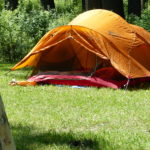
Ready for summer
So, Memorial Day is upon us! Let’s get outside and play! This is a link to the National Wildlife Federation’s website. Share your summertime stories with others.
 |
| The 14th annual Great American Campout™ kicks off Saturday, June 23rd but with Memorial Day weekend upon us, now is a great time to get outside and jumpstart your summer of camping- no skill required! Pledge now through October to join thousands of campers across the country who will be camping to help Protect America’s Wildlife. And don’t miss out on your chance to a win a week-long stay at a Yogi Bear’s Jellystone Park™ Camp-Resort of your choice!
Your pledge also counts towards our goal of 200,000 campers which will allow the National Wildlife Federation’s Trees for Wildlife™ program to donate 5000 native trees to help wildlife.
Tell us about your public Campout event and encourage others to join in on the fun around your campfire! |
by Winding Pathways | May 17, 2018 | Bugs, Garden/Yard, Nature, Pests
Creepy Crawlers
Even before Lyme disease created a serious tick-borne health hazard no one wanted ticks crawling on them. We sure don’t want them at Winding Pathways and because our yard has tall grass, shrubs, and a woodland we have tick habitat.
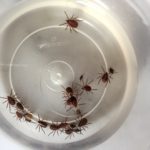
Collection of ticks
A few years ago, Rich contracted Lyme Disease caused when a tick injected bacterium into him. Thanks to a wise physician and effective antibiotics he was cured, but it’s possible to get Lyme Disease again and again. We’re more cautious about avoiding ticks now.
Ticks of many species live throughout most of the United States. They’re common in brushy, grassy, and woodsy habitat but they also love living in yards. It’s possible for a tick to enjoy a human meal even if that person never leaves a mowed yard.
Natural Tick Predators
Although naturalized yards are sometimes good tick habitat they also attract tick predators that love to snack on the tiny invertebrates. Many small birds, including warblers, wrens, and brown creepers among them quickly convert any tick they find into lunch.
Possums Are Us!
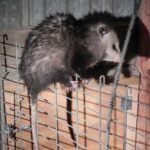
Opossums groom themselves carefully.
A newly understood tick-lover is the common opossum. Many people consider this ancient marsupial a homely animal and would prefer to not have one in their yard, but they might want to rethink this. According to the Carey Institute, opossums are tick vacuum cleaners. As they walk through a yard ticks hitch a ride, thinking they will be able to burrow into the animal’s skin and feast on warm blood. The tick doesn’t realize that possums groom their fur often and comb out ticks. These are readily eaten by the always hungry mammal. Having an opossum in the neighborhood can reduce tick numbers.
Foxes and Coyotes
Small predators, like the fox, are also valuable in tick reduction. According to a study by Dr. Hofmeester, Foxes and coyotes eat mice that ticks feed on. Ticks need three meals before they can reproduce, so more foxes and coyotes can reduce the mouse population and thus, the tick population by “…breaking the cycle of infection.”
Life Cycle
Tick numbers are also associated with climate change and abundance of food. Dr. William H. Schlesinger in an April 2018 issue of Citizen Scientist wrote about the work of Rick Ostfeld with the Carey Institute. The occurrence of ticks one year relates to mice numbers the year before, which relates to food abundance in previous years. The chain of life! And, according to Ostfeld, white-tailed deer are less implicated, unlike initial beliefs, and turkeys also appear to help reduce tick numbers. That is great news for us at Winding Pathway because the wild turkeys pretty much take over our yard at times!
Gobbling Guineas
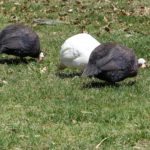
Guineas eat ticks.
A domestic bird that loves ticks is Guineas. They are tick lovers. They are African natives that have been domesticated. Elise Gallet de St Aurin, of Cheshire Moon Farms, told us the guineas that roam her farm near Atkins, Iowa, keep it clear of ticks. These attractive but loud animals roam widely, roost in trees, and eat all sorts of invertebrates, including ticks.
It’s impossible to buy or confine an opossum. But, guinea chicks can be ordered from Hoover’s Hatchery. Some people also enjoy eating guineas.
Repelling Ticks
A simple way to reduce odds that a tick will hitchhike on a person is to use repellents and chemicals that kill them. Any insect repellent containing DEET will repel ticks. Spray it heavily on the legs and arms and on clothing, especially pant legs, shoes, and socks. DEET doesn’t persist long and disappears after clothes are washed so it needs to be reapplied often.
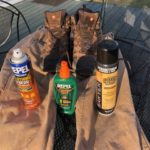
Various forms of tick repellent.
A more permanent solution is to use a spray containing permethrin. This chemical actually kills the ticks. It lasts a long time, even through several wash cycles. It should not be applied to the skin. We spray it on our pants, socks, and shoes. One set of Permethrin-sprayed-pants remains hung in our cabin – not in the house – to put on when we are venturing in likely tick habitat.

Protect yourself with gaiters
Ticks usually access a person from down near the ground. They’re most likely to cling to pant legs or socks and then walk uphill on the skin. Tucking pants into socks makes life harder for these pesky animals, and we take it one step further. We bought a pair of tick gaiters from Forestry Suppliers, Inc. They cost about $11 and fit over shoes and pant legs, forming a tight seal.
Tick Checks
Doing a “tick check” is important. After being outside take a hot sudsy shower and check the body over for ticks. Fortunately, they usually wander around on the skin for several hours before burrowing in. A tick that has not penetrated the skin won’t spread disease and often is simply washed down the drain. Launder the clothes right away.
Ticks deserve respect. They can spread serious disease and they lurk where people often go. Don’t let a fear of ticks keep you inside. Go outside and play but take precautions to reduce the chances of catching a tick-borne illness.
by Winding Pathways | May 3, 2018 | Birds, Mammals, Nature
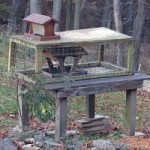
Keeping Squirrels at bay
Bruce Frana, a Winding Pathways visitor, saw one of our blogs on our “squirrel proof” feeder and how we discourage squirrels from gobbling up sunflower seeds we put out for birds. He crafted a similar but much more attractive version that’s in his yard. Our contraption is a box framed with 2X2 lumber with sides of 2” x 2” wire mesh. A piece of plywood forms the roof, and we attached it to a wooden table with a pair of hinges. The hinges let us lift the cage to sprinkle sunflower seeds inside.
It works. Sort of. Cardinals, chickadees, and nuthatches easily pass through the wire mesh to feed. Some squirrels and wild turkeys, which we like but get frustrated when they gobble up all the seed, can’t get through the mesh. Our fox squirrels are too chunky to squeeze through, but smaller gray squirrels manage to get in and gobble seeds. We could keep the grays out if we could find 1 ¾ x 1 ¾ mesh wire on the market. As far as we know it doesn’t exist, but if it did it would let birds in but exclude even the skinniest gray squirrel.
Bruce reports that his fox squirrels can’t enter either but the grays do. Here is a photo of his squirrel foiling feeder:
Do It Yourself “Squirrel Proof” Feeder!
Here is what he shared: “I have had a platform feeder for several years but, like your blog mentioned, turkeys, and even some clever squirrels, were able to get on top of it. I built (a feeder) based on the plan/picture you shared on your blog. I adapted the plan to the platform feeder I had and made some of my own modifications.
“As you can see from the pictures, I attached the structure onto the original platform by using hinges, just as your plan had done. I also put a pitched roof and handle to be able to easily lift the one end to place seed on the platform. The entire system is attached to a 2″ PVC pipe that slides over a steel post. I have had one ingenious small grey squirrel figure out how to get into the feeder and solved that problem, at least for now, by making the wire openings a bit smaller on two sides.” It works…sort of!”
Readers can go online and find “Do It Yourself” (DYI) “squirrel proof” feeder instructions. Good luck and let us know how it goes! Thanks, Bruce Frana.
-
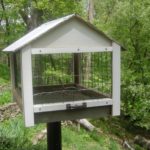
-
Adaptation to feeder
-
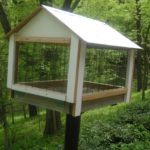
-
Back View of feeder
by Winding Pathways | Mar 29, 2018 | Birds, Nature

Geese mate for life.
“Loose as a goose” is an apt expression. Many people dislike Canada Geese for their habit of depositing droppings on trails and lawns. Despite their mess geese are intriguing birds, especially if they are carefully observed. We enjoy watching them all year and love the goose music they treat us to as they wing over our home at Winding Pathways.
Young Canada Geese form pair bonds early in their lives and have high fidelity to their mate for what can be a long life together. Urban geese enjoy an enviable lifestyle. They eat lawn grass and insects common in town and also snack on grain dropped from railroad cars and an occasional dying gizzard shad. Food is plentiful, and few predators pester adult geese. They have plenty of time for loitering and often socialize and rest with the flock in the shade on hot summer days or in the sunshine when the temperature is cool.
Coupling Up
Geese follow an easy to observe pattern. In late February or early March, goose couples separate from the flock and can often be seen together. Males and females are identically marked. But the male ganders are usually slightly larger and have a thicker neck than their mate. Females make a nest sometimes hidden in vegetation on the ground and lined with a few sticks and goose down. Often their nest is on a muskrat house or another high spot. Sometimes they’ll even nest on a platform up in a tree. We’ve even seen one couple that became squatters in an eagle nest!
So, the nest can be hidden or very visible. It is usually near water. The female lays two to eight eggs and begins incubating once the entire clutch is complete. They hatch in 25 to 28 days, so most goslings appear in early to mid-April.
Parenting

Goslings with the adult.
Geese are wonderful parents and defend their nest and babies from intruders. This includes bicyclists and trail walkers! Geese spend hours teaching their babies how to find food and avoid hazards. Few raccoons, foxes, or other predators are big and bold enough to kill an adult, and mature geese aggressively protect goslings. They hiss if a human or dog approach too closely.
Baby geese grow amazingly quickly and by late summer are only slightly smaller than their parents but otherwise look the same. Following the mating season geese flock up in large groups of family and friends and stay together until next spring’s mating season.
Feasting and Loafing
Many geese spend their nights on and near urban ponds and rivers. Early each morning they fly to farm fields to feast on waste grain and grass. Often, they return to town in the late afternoon to treat humans to their beautiful call as they wing overhead. They are one of our favorite birds to see and hear at Winding Pathways.
by Winding Pathways | Mar 26, 2018 | Birds, Children/Play, Nature
“Something Going On in that Tree”
Guest Blog by Wahneta Dimmer
Todd and I sat at the breakfast table – coffee for me and a coca cola for him – looking out the sliding glass doors at the backyard and out into the park beyond. As he half read the newspaper Todd said, “Hey, look in the tree, there is a big bird sitting on that lower branch.” It took me a minute to find the object he was focusing on but sure enough, there in the early morning light, sat a large bird shadowed by snow-covered branches. We are accustomed to having many small birds visit our feeders throughout the winter but to see a predatory bird is rare. And so low and close to the house, seemingly eyeing the park for prey, is exceptional! We watched for a while before going on about our morning.
Both the kids were spending their third day home from school, recovering from a winter virus, not too sick to stay in bed but just miserable enough to lay low. Kael was standing at the same sliding glass doors when he excitedly exclaimed, “There is a fight or something going on in that tree, Mom.” I told him about the large bird his dad and I had seen earlier in the morning. As we watched, snow was flying out of the upper branches and cascading downward. Kael imagined the bird duking it out with a squirrel! Suddenly, the bird dropped from the tree and flopped into the snow. I said to Kael that it looked like a red-tailed hawk. He wasn’t sure he agreed but we thought we should investigate.
Reconnaissance, Research and Rescue
We both hastily bundled up and headed out across the backyard. As we approached the landing zone, the bird jumped away dragging a wing with him. Kael and I agreed on two things: positively a red-tailed hawk and clearly, injured. Knowing any attempt to get closer would exhaust its remaining reserves, we retreated to the house and called for backup. Kael researched online what to do with an injured raptor and settled on the RARE program. According to their website, the program focuses on rescue, triage and long term medical treatment of injured, sick and distressed raptors. Todd and the kids asked for advice on how to gently capture the bird and safely transfer it to the Iowa City facility. They settled on a wool blanket and dog carrier and as the best options.
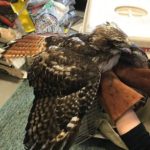
Injured Hawk
True to February in Iowa, it was sunny and brisk with temperatures in the mid 30s and a breeze that made you think is was much cooler. Todd, Kael and Ava headed out into the park just after lunch to relocate the missing, injured raptor. The guys went to the right toward the ball diamond while Ava intuitively chose to head out the gate to the left. Within minutes, Ava located the injured hawk resting at the base of a crab apple tree. She called the guys over, and taking the advice of the RARE associate, they got just close enough to toss the wool blanket gently over the hawk and then Todd scooped him up! The poor bird was so cold and tired, he didn’t even fuss when they put him in the dog carrier, covered him up again and closed the door. As they drove to Iowa City, they wondered aloud what had happened to it and whether it would recover.
Rehabilitation
When they arrived at RARE, rehabilitator, Nikki Herbst, greeted them, assessed the newest arrival, determining it probably was a male hawk, and told them about what the rehab center does. She even introduced them to some of the permanent residents, those too injured to be released into the wild. “Miss Nikki” wasn’t too optimistic as she assessed the hawk. It seemed too weak to stand on its own, much less eat.

Ava Rare Champion Hawk Award
She was kind enough to award the kids with a RARE Wildlife Champion Award and thanked them for their service. Her parting words were, “No news is good news,” meaning she would only call us if he died. If he were to be released, it would be done with discretion at the same place that the bird was found.
Release
Five weeks later, much to our surprise, we received a joyous call from “Miss Nikki.” She was eager to share the news that our hawk rescue was successful, and he was ready to be released. She wondered if we would like to participate?! She went on to say that he was back to his feisty self and flying around the indoor enclosure as high to the ceiling as he could. He was completely recovered from his injury, a broken femur! We agreed on a time with the place predetermined, the park – just outside our backyard.

Dimmer family with Nikki and hawk
After a few family pictures and with the hawk in a box, “Miss Nikki” coaxed the Red-Tailed Hawk from his cardboard carrier and invited him to see again the park and his home. With a count of one, two and three, she encouraged him into the air and off he flew. He paused for a moment at the top of an oak tree before taking off across the park.
Three cheers for the Red-Tailed Hawk, for lessons learned and for good deeds done!
We have a RARE chance to help out: The Raptor Advocacy Rehabilitation & Education (RARE) is based out of Iowa City and is a 501c3 organization. For more information please visit their website at www.theraregroup.org
Photo Journey of Release
-
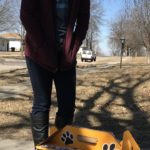
-
Ava by carrier.
-
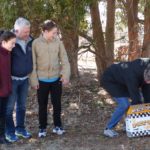
-
The Dimmer family watches as Nikki brings hawk out of the carrier.
-
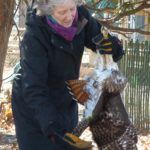
-
Hawk out of box
-
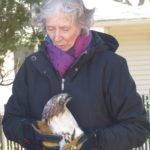
-
Woman hold hawk
-
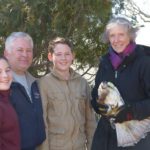
-
Ava, Todd, Kael, “Miss Nikki” and hawk.
-
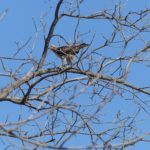
-
Hawk in tree
by Winding Pathways | Mar 17, 2018 | Garden/Yard, Geology/Weather, Mammals, Nature, Wonderment
Don’t Miss March’s Launch of Spring
“If we do not permit the earth to produce beauty and joy
it will in the end not produce food either,” Joseph Wood Krutch.
Too many people miss March’s majesty by staying indoors. After all it’s usually too warm to enjoy cross country skiing or ice fishing and it’s too early to plant the garden, go fishing, or play golf. March is the month of mud, fog, slowly melting grit-encrusted snowbanks, and clammy cold.
At Winding Pathways, we defy normal behavior and spend March days outdoors. It’s the month of great change and nature’s cavalcade is there for any observant person to enjoy.
Just consider the earth and how it’s turning toward our sun. Days lengthen the most around the March 21st Vernal Equinox. This means there is more sunlight each day allowing our yard to soak up more solar energy and spark spring’s revival of life.
March is the month to pull on mud boots and venture outdoors with eyes and ears attuned to the great seasonal change upon us. Here are some things to absorb with great joy:
-

-
“Possum come aknockin’ at the door.”
-

-
Look Up and see skeins of geese winging across the sky
-
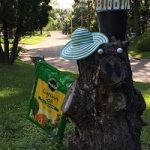
-
Gardening
Birds.
Migration has started. Look up! Way up. Skeins of geese wing high overhead, perhaps so high they are mere specs. Binoculars bring them closer. And their distant and distinct song is music to winter weary ears. Salute their northward journey with a hearty, “Welcome Back!” Many smaller birds are on the prowl, but it may take a close look to notice them. Within a month juncos disappear shortly after red winged blackbirds make their annual debut. Sparrows begin crafting messy nests as goldfinches swap their drab winter outfits for glorious yellow garb. Barred owls fill the night air with haunting cries of WHO COOKS FOR YOU FOR YOU. Sometimes they are in a black oak almost over our roof and startle us awake with their lusty calls.
Mammals.
Even as winter’s song hangs on, baby squirrels are nestling in tree cavities and rapidly growing on a diet of mom’s rich milk. Squirrels are among nature’s most attentive mothers. In another month or two they encourage their babies to venture outdoors. Cottontails begin mating, buck deer begin growing new antlers, chipmunks are increasingly active, and raccoons and opossums prowl the nocturnal yard seeking dinner. On warm misty nights they gorge on nightcrawlers that have emerged on the lawn’s surface to mate.
Plants.
We’re always delighted to find stinging nettles springing out of the still cold earth toward the end of March. There’s no better tasting or nutritious cooked green than a short pile of steaming bright green nettles on the dinner plate. It’s the best time of the year to enjoy tender dandelions leaves in salad. We like the non-bitter blanched leaves discovered under a carpet of oaks. By summer, these leaves are too tough and bitter to enjoy. But, now, they are delicious and nutritious. We can pluck them because we have a spray-free yard.
Spring’s miracle sound.
Sometimes this miraculous sound happens in March but always by early April. Nature’s most promising song comes at vespers each spring, usually in the calendar interval where Easter can fall – March into April. Spring peepers and chorus frogs herald the season each evening. As Christians worldwide celebrate Easter by saying HE IS RISEN, Chorus frogs and peepers enthusiastically seem to announce SPRING IS COMING!
Go Outside! Don’t miss the great vernal seasonal turn. March isn’t a month to huddle by the television. It’s a month to be outside.
-
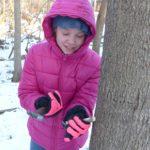
-
Girls taps a Maple Tree
-
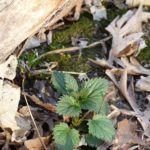
-
Nettles are one of the first greens to poke up through the ground.
-
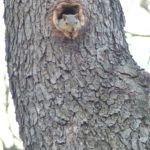
-
Young Squirrel in tree.
-
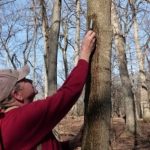
-
Sapsucker holes in tree.
-
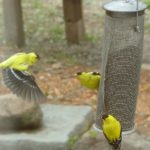
-
Male Goldfinches begin to color up.
-
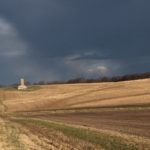
-
Dark clouds over farmland.





























